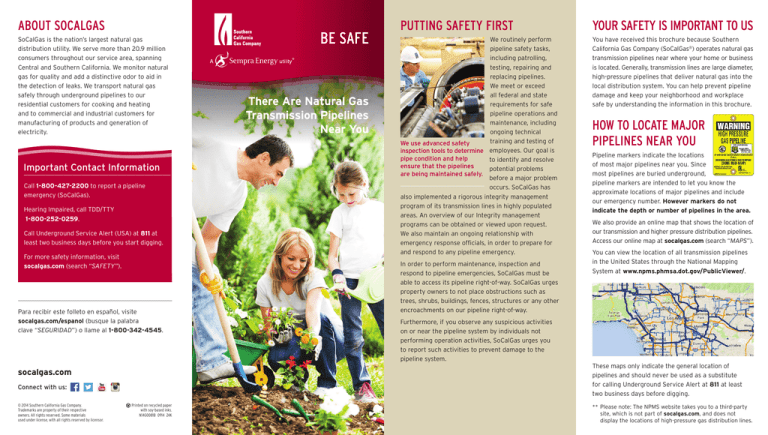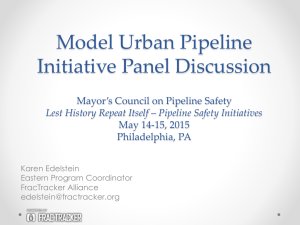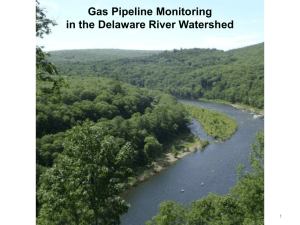
ABOUT SOCALGAS
SoCalGas is the nation’s largest natural gas
distribution utility. We serve more than 20.9 million
consumers throughout our service area, spanning
Central and Southern California. We monitor natural
gas for quality and add a distinctive odor to aid in
the detection of leaks. We transport natural gas
safely through underground pipelines to our
residential customers for cooking and heating
and to commercial and industrial customers for
manufacturing of products and generation of
electricity.
Important Contact Information
Call 1-800-427-2200 to report a pipeline
emergency (SoCalGas).
Hearing Impaired, call TDD/TTY
1-800-252-0259.
Call Underground Service Alert (USA) at 811 at
least two business days before you start digging.
For more safety information, visit
socalgas.com (search “SAFETY”).
Para recibir este folleto en español, visite
socalgas.com/espanol (busque la palabra
clave “SEGURIDAD”) o llame al 1-800-342-4545.
There Are Natural Gas
Transmission Pipelines
Near You
YOUR SAFETY IS IMPORTANT TO US
We routinely perform
pipeline safety tasks,
including patrolling,
testing, repairing and
replacing pipelines.
We meet or exceed
all federal and state
requirements for safe
pipeline operations and
maintenance, including
ongoing technical
training and testing of
We use advanced safety
inspection tools to determine employees. Our goal is
pipe condition and help
to identify and resolve
ensure that the pipelines
potential problems
are being maintained safely.
before a major problem
occurs. SoCalGas has
also implemented a rigorous integrity management
program of its transmission lines in highly populated
areas. An overview of our Integrity management
programs can be obtained or viewed upon request.
We also maintain an ongoing relationship with
emergency response officials, in order to prepare for
and respond to any pipeline emergency.
You have received this brochure because Southern
California Gas Company (SoCalGas®) operates natural gas
transmission pipelines near where your home or business
is located. Generally, transmission lines are large diameter,
high-pressure pipelines that deliver natural gas into the
local distribution system. You can help prevent pipeline
damage and keep your neighborhood and workplace
safe by understanding the information in this brochure.
In order to perform maintenance, inspection and
respond to pipeline emergencies, SoCalGas must be
able to access its pipeline right-of-way. SoCalGas urges
property owners to not place obstructions such as
trees, shrubs, buildings, fences, structures or any other
encroachments on our pipeline right-of-way.
HOW TO LOCATE MAJOR
PIPELINES NEAR YOU
Pipeline markers indicate the locations
of most major pipelines near you. Since
most pipelines are buried underground,
pipeline markers are intended to let you know the
approximate locations of major pipelines and include
our emergency number. However markers do not
indicate the depth or number of pipelines in the area.
We also provide an online map that shows the location of
our transmission and higher pressure distribution pipelines.
Access our online map at socalgas.com (search “MAPS”).
You can view the location of all transmission pipelines
in the United States through the National Mapping
System at www.npms.phmsa.dot.gov/PublicViewer/.
Furthermore, if you observe any suspicious activities
on or near the pipeline system by individuals not
performing operation activities, SoCalGas urges you
to report such activities to prevent damage to the
pipeline system.
These maps only indicate the general location of
pipelines and should never be used as a substitute
for calling Underground Service Alert at 811 at least
two business days before digging.
socalgas.com
Connect with us:
© 2014 Southern California Gas Company.
Trademarks are property of their respective
owners. All rights reserved. Some materials
used under license, with all rights reserved by licensor.
BE SAFE
PUTTING SAFETY FIRST
E Printed on recycled paper
with soy-based inks.
N14G0081B 0914 24K
** Please note: The NPMS website takes you to a third-party
site, which is not part of socalgas.com, and does not
display the locations of high-pressure gas distribution lines.
HOW TO RECOGNIZE
A PIPELINE LEAK
DAMAGE TO A
PIPELINE OR METER
UNDERGROUND UTILITIES
COLOR CODE
WHAT YOU SHOULD DO
BEFORE YOU DIG
Be alert to signs you may see, hear or smell when
there’s a gas leak.
Leaking gas from any damaged pipeline or gas meter
could cause a fire, explosion, property damage and
serious bodily injury.
The following color code is used by utilities for marking
excavation sites and underground facilities in conflict
with an excavation.
• MARK OUT your
proposed excavation area
in white paint or provide
other suitable markings.
Look
• Dirt or water being blown in the air
• Dead or dying vegetation (in an otherwise moist
area) over or near pipeline areas
• A fire or explosion near a pipeline
• Exposed pipeline after an earthquake, fire, flood
or other disaster
Listen
• An unusual sound, such as a hissing, whistling
or roaring sound near a gas line
Smell
• The distinctive odor* of natural gas
* Some persons may not be able to smell the odor
because they have a diminished sense of smell,
olfactory fatigue (normal, temporary inability
to distinguish an odor after prolonged exposure
to it) or because the odor is being masked or
hidden by other odors that are present, such
as cooking, damp, musty or chemical odors.
In addition, certain conditions in pipe and soil
can cause odor fade—the loss of odorant so
that it is not detectable by smell.
Follow these guidelines if you encounter a leaking
gas pipe or meter:
• REMAIN calm.
• DON’T light a match, candle or cigarette.
Red: Electric
Yellow: Gas, oil, steam
Orange: Communications
— Don’t turn electrical devices on or off, including
light switches.
Blue: Water
— Don’t start an engine or use any device, including
a telephone, which could cause a spark.
Green: Sewer
• IMMEDIATELY EVACUATE the area, and from a
safe location, call SoCalGas at 1-800-427-2200
24 hours a day, seven days a week.
Purple: Reclaimed water
Pink: Temporary markings
White: Proposed excavation
• CALL 911 promptly after evacuating the area if the
damage results in a natural gas leak that may endanger
life or cause bodily harm or property damage.
CALL 811 BEFORE YOU DIG.
IT’S FREE.
• DO NOT attempt to control the leak or repair the
damaged pipe or meter. Do not use or turn off any
equipment that could cause a spark. Motorized or
electrically powered equipment or vehicles may create
an ignition
source if a gas
leak is present.
Safely abandon
any motorized
or powered
equipment or
vehicles. Gas
leaking from
a plastic pipe
can create
static electricity
that can ignite
the gas.
Excavation, planting,
demolition and other forms
of digging are major causes
of pipeline damage. For your
safety, and the safety of
those around you, it is
important to know where
pipelines are before you begin any type of
digging. Whether you’re planning to build a major
development or just landscaping your yard, call 811
at least two business days before you dig. Calling
811 connects you to Underground Service Alert,
a free service that coordinates with SoCalGas and
other utility companies to have the locations of buried
utility-owned pipelines and other utility-owned lines
marked. Note that utilities do not mark customer-owned
lines such as gas piping to a pool heater, fire pit or
bar-b-que.
• CALL Underground
Service Alert at 811 from
6 a.m. to 7 p.m., Monday
through Friday (excluding
holidays) at least two
business days before
digging.
• WAIT until we either
mark our gas pipelines
and indicate pipe material
and diameter—or advise
you the area is clear of
our pipes, before you
start digging.
• REMEMBER that we use only yellow paint, flags
or stakes to mark out the location of our gas pipes.
Other utility owners use other colors to mark their
telephone, communications, water or other
underground lines.
• USE ONLY HAND TOOLS within 24 inches of each
marked utility line to determine the exact locations
of all lines before using any power excavation
equipment in the area.
• REPORT any pipe damage by calling SoCalGas
immediately at 1-800-427-2200. No damage
is too small to report. Even a slight gouge,
scrape or dent to a pipeline, its coating, or any
component attached to or running alongside
the pipe, such as a wire, may cause a dangerous
break or leak in the future.





